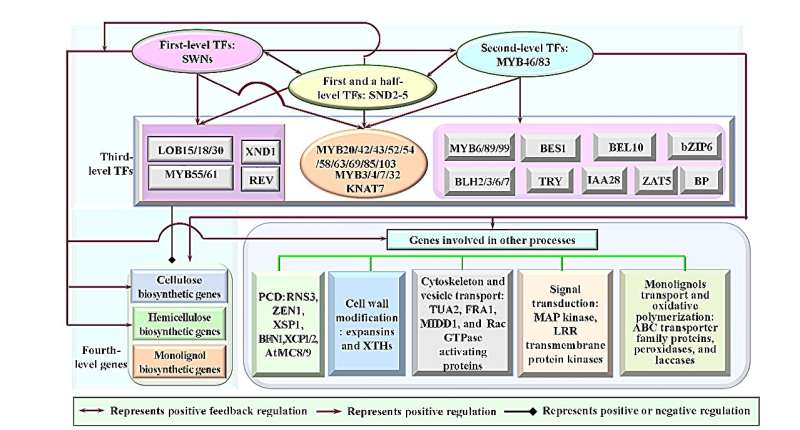This article has been reviewed according to Science X's editorial process and policies. Editors have highlighted the following attributes while ensuring the content's credibility:
fact-checked
peer-reviewed publication
proofread
Unveiling and decoding the regulatory mechanisms of secondary cell wall formation

Wood quality is primarily determined by the properties of its secondary cell wall (SCW). Gaining insight into the molecular processes governing SCW development is crucial for the genetic enhancement of wood quality. Although it's established that a multilayered gene regulatory network, operating at the transcriptional level, orchestrates SCW development, our grasp of its response to environmental fluctuations, and the resultant diverse SCW structure, is incomplete.
In December 2023, Horticulture Research published a review article titled "Deciphering the Intricate Hierarchical Gene Regulatory Network: Unraveling Multi-Level Regulation and Modifications Driving Secondary Cell Wall Formation."
Research has predominantly focused on SCW formation in model species like Arabidopsis and poplar. Despite the fundamental conservation of SCW regulatory processes, notable distinctions between woody and non-woody plants remain inadequately explored.
Recent studies indicate that SCW development is also subject to chromosome-level, post-transcriptional, and post-translational regulation and modifications, yet the interplay between these factors and the transcriptional network is not fully understood.
To address these gaps, researchers re-evaluated and synthesized the transcriptional networks related to SCW formation, considering all recognized transcription factors in Arabidopsis and poplar. Their analysis sheds light on the intricate regulatory modules and motifs within the network, offering insights into the transcriptional network's role in generating diverse SCW structures.
They also systematically examined the variations in the transcriptional regulatory networks between woody and non-woody plants. Incorporating chromosomal, post-genetic, and protein-level adjustments, they propose a more elaborate model of SCW regulatory mechanisms.
The researchers outline current challenges and potential research directions in SCW regulatory mechanism studies. Their review aims to enrich the understanding of the regulatory intricacies and dynamic nature of SCW formation, guiding researchers through the evolving landscape of this research area.
More information: Zhigang Wei et al, Deciphering the Intricate Hierarchical Gene Regulatory Network: Unraveling Multi-Level Regulation and Modifications Driving Secondary Cell Wall Formation, Horticulture Research (2023). DOI: 10.1093/hr/uhad281
Journal information: Horticulture Research
Provided by BioDesign Research




















